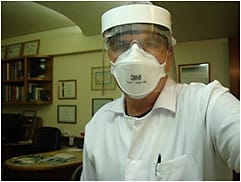
Managing High Myopia with an Intralimbal GP Design
This 54-year-old male telecommunications technician came to us for the first time in November 2009. He was incorrectly diagnosed with keratoconus; we determined that he had bilateral high myopia, with a normal corneal thickness, a large palpebral fissure, and a large corneal diameter of 12.3mm. He currently wears an intralimbal aspherical GP design.
Corneal Biomicroscopy and History
During his first examination in 2009, this patient was wearing a flat lens that had a poor peripheral fit, and his eyes presented severe hyperemia. He was instructed to suspend lens wear for three days and to return for a follow-up exam and contact lens evaluation. Figure 2 shows the trial intralimbal lens over the cornea, with several areas of superficial keratitis from the previous lens. He had stopped wearing a lens on this eye just one day prior to the first visit.

We observed that the patient had a low tear meniscus, which made us suspect dry eye; after anamnesis and overall observation of the anterior eye, we determined that the patient had an evaporative dry eye condition. The large palpebral fissure, combined with his occupation—which requires long hours in front of a computer screen and at which there is lower humidity due to air conditioning—all contribute to aggravate his symptoms.
We prescribed artificial lacrimal tears q.i.d and also instructed the patient to make an effort to blink more frequently.
It is important to mention that high-myopia patients should be carefully examined, as the higher the myopia, the higher the risk of a subsequent pathology such as retinal detachment, glaucoma, cataract, and macular degeneration.1,2
Discussion
The reason we opted to use a large intralimbal GP design was because the patient has a flat, large cornea with a large palpebral fissure. A smaller corneal GP lens would move excessively and would result in an unstable fitting. The upper lid would dislocate the lens, either pushing it down or pulling it up; excessive movement in GP fitting is something that we need to avoid.
The patient came for a refit in April 2021. Since his first fitting in 2009, he had worn this design with no complications. The lens parameters OD were base curve (BC) 40.50D (8.33mm), –15.25D power, overall diameter (OAD) 12.5mm, optic zone (OZ) 8.0mm, Optimum Extra (Contamac) material (Dk 100).
The intermediate curve of a 9.5mm diameter GP lens is thinner compared to a large intralimbal diameter of 12.5mm, but it would decenter during blinking, leading to awareness and dislocating the central optics, affecting vison. Figure 3 shows the aspheric-front-surface design with a plus flange.

You may be wondering why I did not fit a scleral lens in this case. We did trial scleral lenses for this patient, but he preferred GPs. Some long-term GP patients do not feel comfortable with the idea of wearing a lens that is larger than that to which they are accustomed. We tried a smaller scleral lens just for an initial evaluation, and we found that he was a good candidate; however, the patient opted to keep the GPs.
The conversation as to whether scleral lenses are more comfortable compared to GPs is not so simple. Patients who wear a well-fitting GP design with high-quality, well-finished edges and periphery may experience great comfort and a full adaptation within five-to-seven days, sometimes even fewer. It is important to correctly instruct patients regarding the initial adaptation period and lens maintenance; it is also important to have patients return for a follow-up evaluation 10-to-15 days from initial dispensing so that they have adequate time to achieve adaptation. This also prevents patients from failing if something is not right with the fitting that was not perceived earlier.
We schedule three follow-up evaluations for first-time GP lens patients within 10, 30, and 90 days from the dispensing day. This is time enough to make adjustments to the fit and also to prevent interruption of the adaptation process. Figure 4 shows the final lens dispensed to the patient in higher magnification with a cobalt blue filter and fluorescein. A video of the fit is available below.

Patients who have larger corneas and palpebral fissures are good candidates for scleral lenses; but if GPs are preferred, it is advised to fit larger-diameter GPs and to use high-Dk materials. Also consider the material’s wetting angle, hardness, and minimum thickness for higher-Dk, larger GPs3 to prevent lens flexure and to assure a better lacrimal distribution and tear exchange, which also depends on lens design.
In high-minus-power lenses, avoid abrupt changes in the anterior curvature to produce the plus flange effect so as to avoid a thick edge.4 The upper lid may dislocate the lens, or there may be lens awareness.
Conclusion
Intralimbal GP lenses can be a good option for patients who do not want or cannot be fit with scleral lenses and when smaller corneal GPs fail to provide a proper fitting. Larger intralimbal GP designs must have a greater eccentricity to avoid touching the peripheral cornea and limbus as well as to facilitate tear exchange.
Eccentricity will impact edge lift, so it is important to consider the size and amount of edge lift necessary for a perfect fitting. The lab can provide support regarding lens modifications when needed; lab consultants are very helpful for these specialty fittings.
References
- Williams K, Hammond C. High myopia and its risks. Community Eye Health. 2019;32(105):5-6.
- Philips AJ, Speedwell L, Eds. Contact Lenses 5th Edition. Butterworth-Heinemann. 2007:474.
- Efron N, ed. Contact Lens Practice 2nd Edition. Butterworth-Heinemann. 2010:145.
- Efron N, ed. Contact Lens Practice 2nd Edition. Butterworth-Heinemann. 2010:300.




